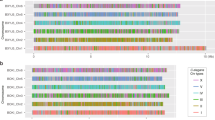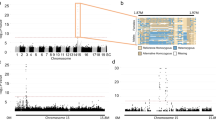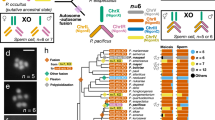Abstract
Sex in the nematode Caenorhabditis elegans is normally determined by a genic balance mechanism1, the ratio of X chromosomes to autosomes, so that XX animals are self-fertilizing hermaphrodites and X0 animals are males2,3. However, recessive mutations of the autosomal gene tra-1 III cause both XX and X0 animals to develop into males4, and a linked dominant mutation causes both XX and X0 animals to develop into females5. Here I show that these two kinds of mutation are allelic, and that stable mutant strains can be constructed in which sex is determined not by X-chromosome dosage but by the presence or absence of a single active gene. In these strains the autosomes carrying the tra-1 locus are in effect homomorphic Z and W sex chromosomes, and the sexes are homogametic ZZ males and heterogametic ZW females, in contrast to the wild-type arrangement of homogametic XX hermaphrodites and heterogametic X0 males.
This is a preview of subscription content, access via your institution
Access options
Subscribe to this journal
Receive 51 print issues and online access
$199.00 per year
only $3.90 per issue
Buy this article
- Purchase on SpringerLink
- Instant access to full article PDF
Prices may be subject to local taxes which are calculated during checkout
Similar content being viewed by others
References
White, M. J. D. Animal Cytology and Evolution (Cambridge University Press, 1973).
Brenner, S. Genetics 77, 71–94 (1974).
Madl, J. E. & Herman, R. K. Genetics 93, 393–402 (1979).
Hodgkin, J. A. & Brenner, S. Genetics 86, 275–287 (1977).
Hodgkin, J. Genetics 96, 649–664 (1980).
Sulston, J. E. & Horvitz, H. R. Devl Biol. 56, 110–156 (1977).
Lauge, G. in Genetics and Biology of Drosophila Vol. 2d (Academic, New York, 1977).
Nelson, G. A., Lew, K. K. & Ward, S. Devl Biol. 66, 386–409 (1978).
Waterston, R. H. Genetics 97, 307–325 (1981).
Wills, N. et al. Cell 33, 575–583 (1983).
Triantaphyllou, A. C. & Hirschmann, H. A. Rev. Phytopath. 2, 57–80 (1964).
Maupas, E. Archs Zool. exp. gen. 8, 463–624 (1900).
Mainx, F. Am. Nat. 98, 415–430 (1964).
Baker, R. H. & Sakai, R. K. J. Hered. 67, 289–294 (1976).
Wachtel, S. S., Ohno, S., Koo, G. C. & Boyse, E. A. Nature 257, 235–236 (1975).
Author information
Authors and Affiliations
Rights and permissions
About this article
Cite this article
Hodgkin, J. Two types of sex determination in a nematode. Nature 304, 267–268 (1983). https://doi.org/10.1038/304267a0
Received:
Accepted:
Issue date:
DOI: https://doi.org/10.1038/304267a0
This article is cited by
-
Expression pattern of Cubitus interruptus from the mulberry silkworm Bombyx mori in late developmental stages
Development Genes and Evolution (2003)
-
Establishing sexual dimorphism: conservation amidst diversity?
Nature Reviews Genetics (2001)
-
A transcription factor controlling development of peripheral sense organs in C. elegans
Nature (1995)
-
Right gene, wrong chromosome
Nature (1988)
-
Genetics: Sex is simple
Nature (1983)



